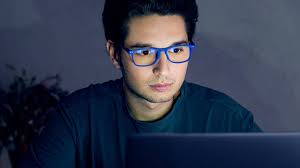Do Blue Light Glasses Work For Eye Strain.In the digital age, where screens have become an integral part of our lives, eye strain and discomfort have become increasingly common complaints. From working professionals staring at computer screens for hours, to students studying online, to our evening habits of watching TV or scrolling social media, the exposure to screens – and the blue light they emit – is immense. One solution that has been touted for relief is blue light glasses. But do they really work?
Do Blue Light Glasses Work For Eye Strain
What is Blue Light?
Before we delve into the efficacy of blue light glasses, it’s essential to understand what blue light is. Every source of light emits a spectrum of colors, which include violet, indigo, blue, green, yellow, orange, and red. Blue light has a shorter wavelength and, therefore, higher energy compared to other colors. Sources of blue light include the sun, LED lights, and, notably, digital screens.
Why the Concern?
Extended exposure to blue light, especially during the evening, can interfere with our natural sleep-wake cycle, potentially disrupting our sleep patterns. Moreover, prolonged screen time can cause digital eye strain, characterized by symptoms like dry eyes, headache, blurred vision, and fatigue.
Blue Light Glasses: The Claim
Manufacturers of blue light glasses claim that these glasses can filter out the blue light emitted from screens, thereby reducing eye strain and improving sleep quality for those who use digital devices before bedtime.
Do They Work?
- Eye Strain: Some users report relief from eye strain after using blue light glasses. It’s possible that the glasses may reduce the amount of blue light reaching the eyes, potentially reducing some symptoms of digital eye strain.
- Sleep Patterns: While it’s clear that excessive screen time, especially before bed, can impact sleep, the jury is still out on whether blue light glasses significantly improve sleep quality. Some studies suggest a modest improvement in sleep for wearers, while others find little to no effect.
- Placebo Effect: There’s a possibility that some benefits users experience might be attributed to the placebo effect. Knowing they’re wearing “protective” eyewear could make users feel more comfortable and relaxed, leading to a perceived reduction in symptoms.
Other Solutions
If you’re concerned about blue light, there are other steps you can take:
- Screen Breaks: Follow the 20-20-20 rule; every 20 minutes, take a 20-second break and look at something 20 feet away.
- Device Settings: Many devices offer “night mode” or “blue light reduction” settings that adjust the color temperature in the evenings.
- Proper Lighting: Ensure that you’re working in well-lit conditions, which can reduce the contrast between the screen and the surrounding environment, minimizing eye strain.
Conclusion
While blue light glasses may offer some relief to users, it’s essential to approach the topic with a balanced perspective. They might be a useful tool in your arsenal against eye strain, but they’re not a panacea. It’s always a good idea to take regular breaks, adjust screen settings, and ensure proper lighting when using digital devices for extended periods.
